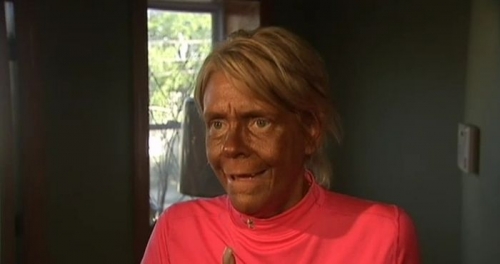If ‘tan mum’ wants a burnt-to-the-crisp complexion, that’s her choice
 WITH her burnt-to-a-crisp complexion, New Jersey’s ‘tanorexic’ mum Patricia Krentcil looks like a poster girl for anti-tanning campaigns. In fact, no sooner had she received notoriety for her exceptionally brown skin (picture captions have even clarified that she is ‘not in blackface’) than health campaigners adopted her as a scarecrow, using her high-profile case as fodder to renew their efforts to extend indoor tanning bans.
WITH her burnt-to-a-crisp complexion, New Jersey’s ‘tanorexic’ mum Patricia Krentcil looks like a poster girl for anti-tanning campaigns. In fact, no sooner had she received notoriety for her exceptionally brown skin (picture captions have even clarified that she is ‘not in blackface’) than health campaigners adopted her as a scarecrow, using her high-profile case as fodder to renew their efforts to extend indoor tanning bans.
Krentcil stands accused of imposing her passion for tanning on her five-year-old daughter after the girl told a school nurse that she got a burn mark after going ‘tanning with mummy’. The 44-year-old mum says that her daughter got the burn from playing outside in the sun. Krentcil believes that she is the victim of a witchhunt and says that whoever is going after her is doing it because they are ‘jealous, they’re fat and they’re ugly’. Move over, Samantha Brick!
If convicted of taking her daughter into the tanning booth, Krentcil could face up to 10 years in prison. She is already a pariah in the indoor tanning community (if there is such a thing), having been banned from salons across New Jersey. But is this extreme tanner really a good example of why tanning is bad for you? And is tanning really bad for you?
The American Cancer Society (ACS) and other health groups think so. They are pushing for a ban on indoor tanning for anyone under 18. Current local laws prohibit under-14s from using indoor tanning beds, but older teenagers can use them if they have parental permission. With some researchers going as far as suggesting that tanning can be a deadly addiction, anti-tanning campaigns are typically not only targeted at minors but also strive to send a message to us all that bronzing is bad.
‘A 43 per cent increase in melanoma cases over the last 10 years’, said ACS’s vice president of advocacies, Blair Horner, ‘that staggering number should be a call to New Jersey lawmakers to act’. He was referring to data from the Archives of Dermatology journal and he apparently believes there is a correlation between the growth in melanoma and the increasing popularity of indoor tanning among young adults in New Jersey.
Sam Shuster, emeritus professor of dermatology at the University of Newcastle-upon-Tyne, disputes claims that indoor tanning is deadly and believes that the push to extend sun tanning bans in the wake of the tanning mum scandal is ‘irrational’.
Shuster has long been a vocal critic of the theory that UV-light exposure causes deadly skin cancer (read a longer interview with him on this topic here). While there is solid proof, he says, that ultraviolet rays cause the most common skin cancers (basal and squamous), when it comes to the more serious melanoma (which, in Britain, accounts for around 10 per cent of skin cancers), ‘the effect of UV light is minimal’, he says.
‘Different studies of the links between UV tanning and melanoma show association, no association and a decrease’, says Shuster. ‘In other words, like most rotten epidemiology you can choose whatever answer you want.’ Further, he says, there has been widespread ‘spurious misdiagnosis of benign lesions as malignant. Melanoma isn’t being found; it is being made. And this error increases mathematically with the increase in size of the population examined and biopsied.’
So Shuster and others believe that the war on UV rays is based on dodgy science. It is also underpinned by the idea that the sun and tanning salons’ alluring promises of bronzed skin turn people into mindless zombies. ‘Dermatologists often talk about people who seem “addicted to the sun” – people who know it’s not good for them to be bronzed all the time, but don’t seem to be able to stop tanning’, a University of Texas professor told Medical News Today. In many people’s opinion Krentcil apparently falls into this category, which is why she’s been labelled a ‘tanorexic’. Krentcil herself insists that she simply likes to tan and has been doing it all her life.
People who choose to bronze on beaches and in tanning salons are depicted by public health campaigners as vain, reckless and unhealthy. They are held up as bad examples, as people prone to self-harm and as burdens to the healthcare system. For Krentcil, it doesn’t help her that she hails from New Jersey, the state whose reputation for tackiness has been cemented by reality shows like The Real Housewives of New Jersey and Jersey Shore.
In this sense, Krentcil, the brash NJ ‘tanning mum’, is a bit of a PR coup for anti-tanning campaigners. She’s being held up as an epitome of all that’s evil about tanning. And her timing couldn’t be better because every spring when temperatures rise and more people rush to tanning salons in pursuit of the perfect summer look, health campaigners begin popping up issuing stark warnings about cancerous rays.
In any case the scaremongers can relax. While the jury is still out on whether Krencil took her young daughter into the tanning booth, the backlash she’s faced suggests that few women want a face to go with their handbag. And for the ones that do, that’s their choice.
Posted: 11th, May 2012 | In: Key Posts, Reviews Comment (1) | TrackBack | Permalink



